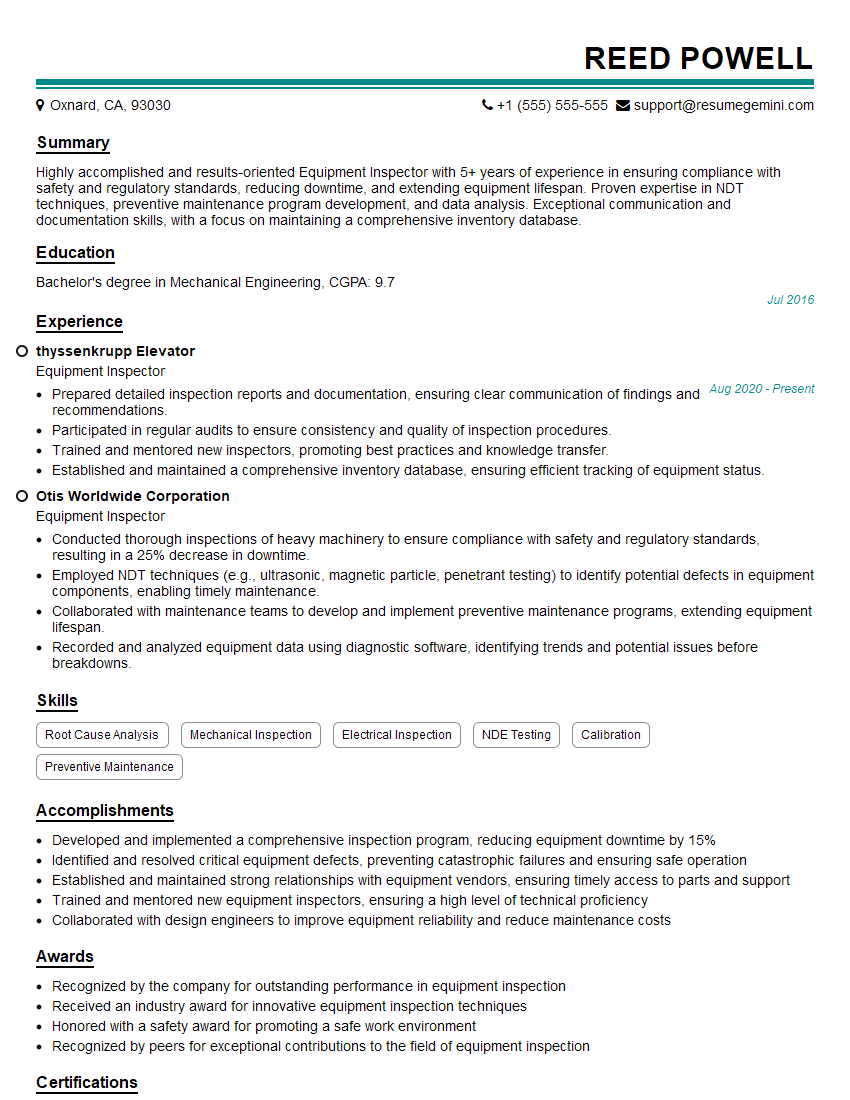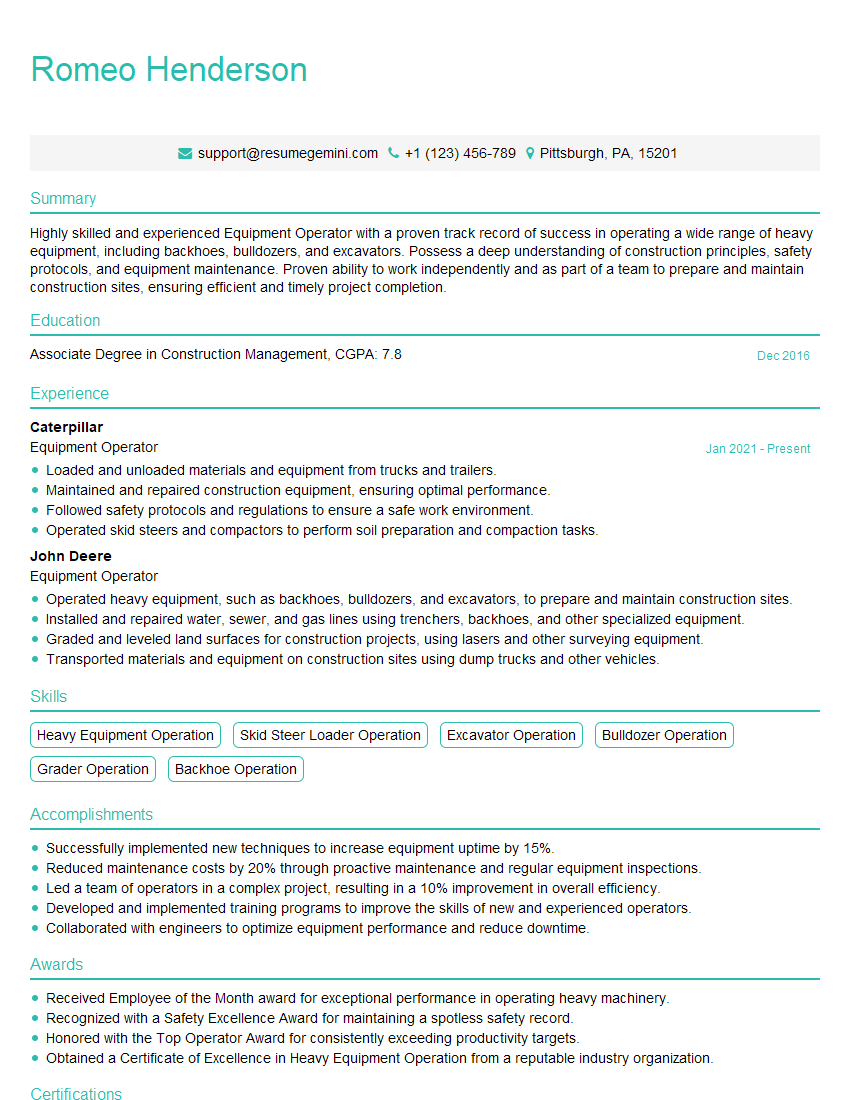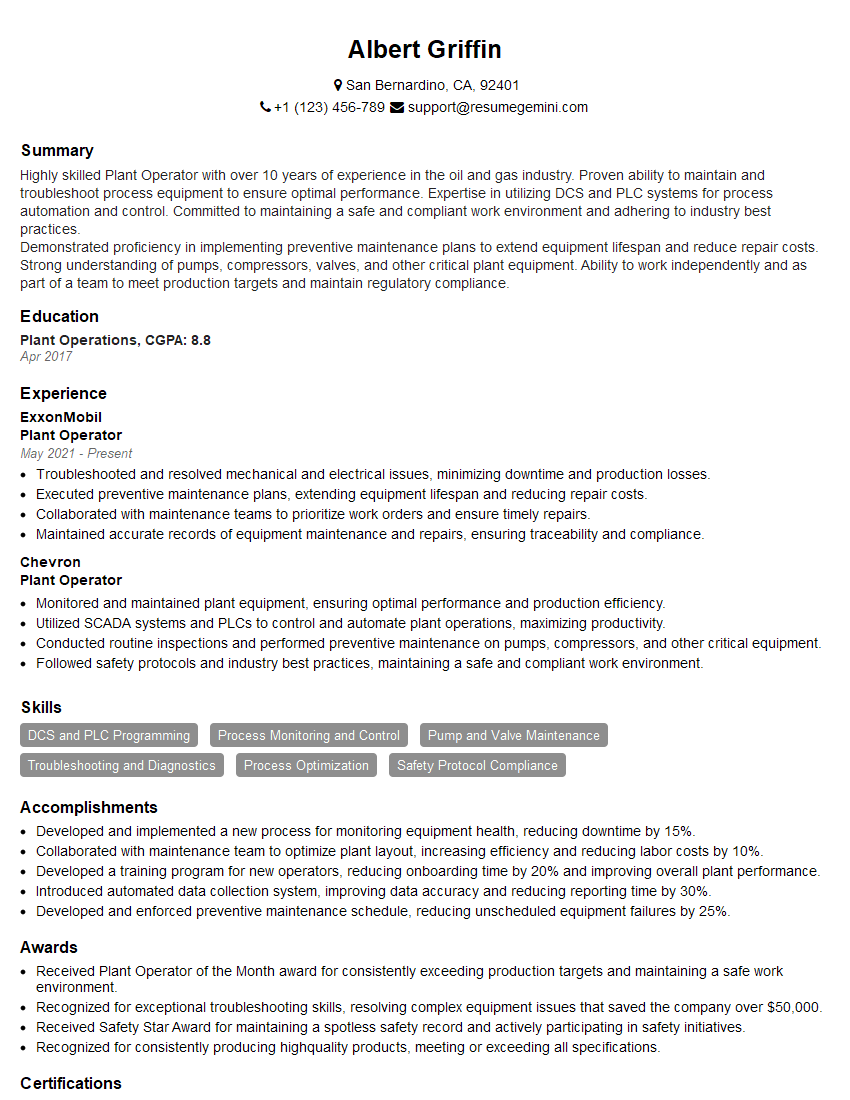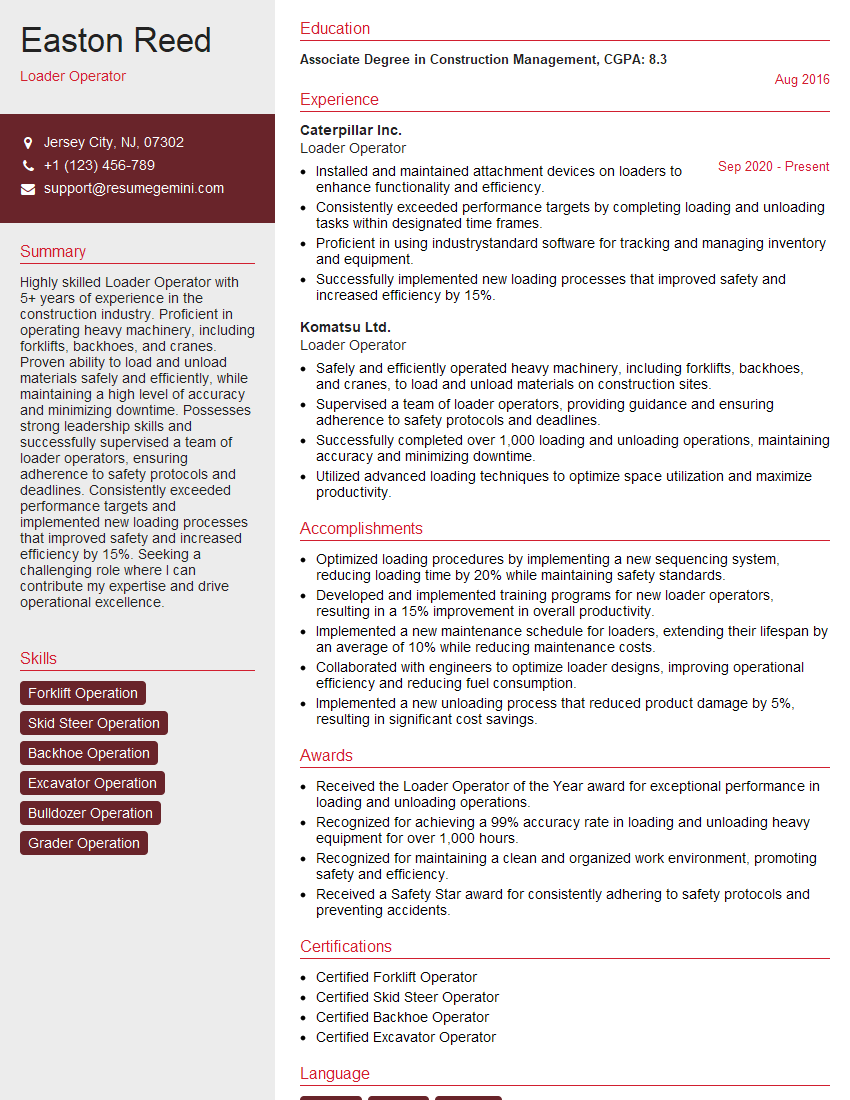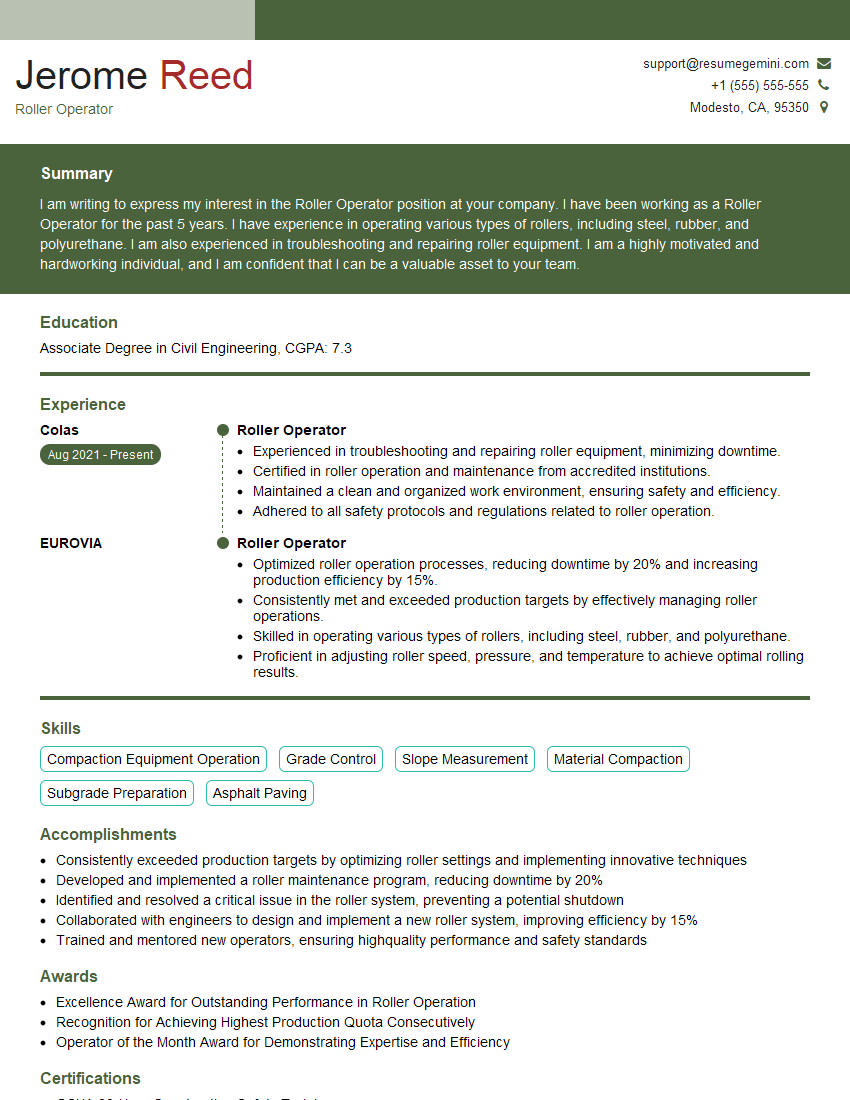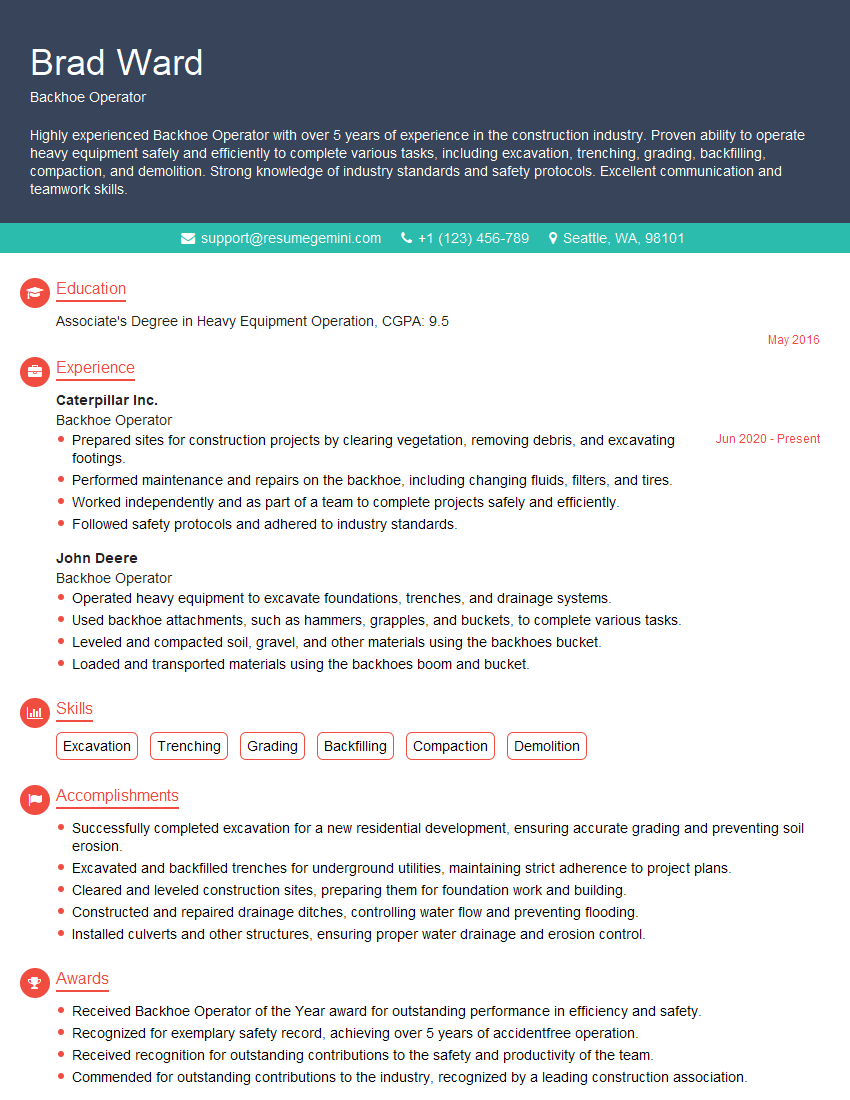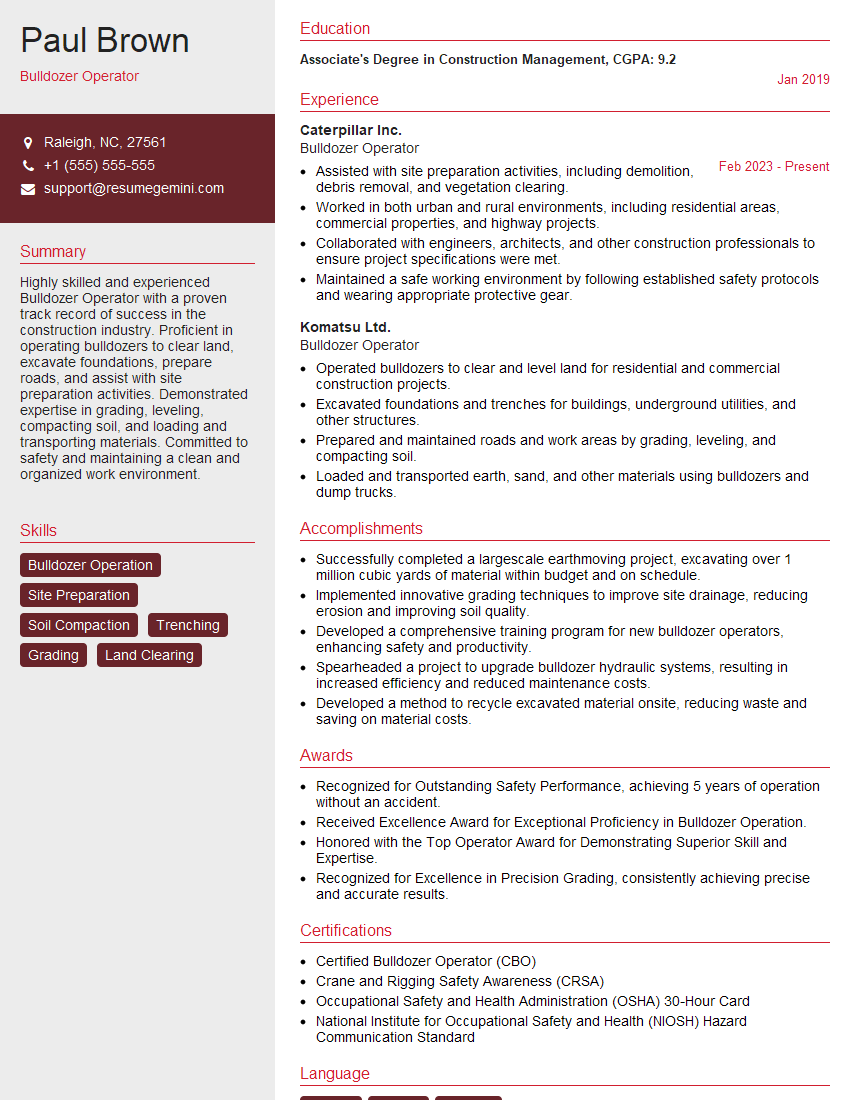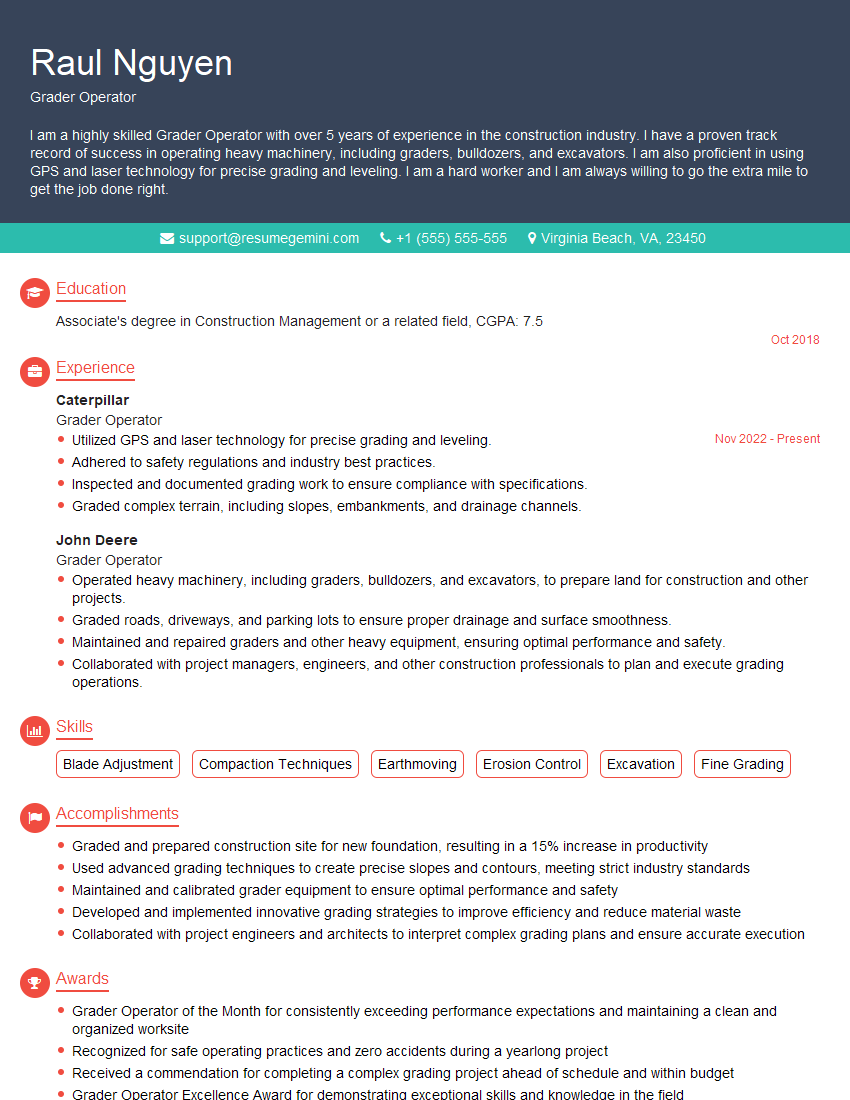The thought of an interview can be nerve-wracking, but the right preparation can make all the difference. Explore this comprehensive guide to Equipment Operation and Safety interview questions and gain the confidence you need to showcase your abilities and secure the role.
Questions Asked in Equipment Operation and Safety Interview
Q 1. Describe your experience with pre-operational equipment checks.
Pre-operational equipment checks are crucial for ensuring the safe and efficient operation of any machinery. They involve a systematic inspection of all key components before starting the equipment. Think of it like a pre-flight checklist for an airplane – you wouldn’t take off without it! My experience encompasses a wide range of equipment, from excavators and bulldozers to forklifts and aerial lifts. Each check is tailored to the specific machine, but generally includes:
- Visual Inspection: Checking for any visible damage, leaks, loose parts, or unusual wear and tear. For example, I’d inspect hydraulic lines for leaks, tire treads for wear, and the cab for any cracks.
- Fluid Levels: Verifying the levels of engine oil, hydraulic fluid, coolant, and transmission fluid. Low levels could indicate a leak or other problem requiring attention.
- Operational Checks: Testing all controls and functions, like steering, brakes, lights, horns, and warning systems. This ensures everything is responsive and working as expected.
- Safety Systems: Confirming the functionality of safety features such as seatbelts, emergency stops, and warning devices. These are paramount for preventing accidents.
For instance, when operating a forklift, I meticulously check the mast for any signs of bending or damage, ensuring the forks are securely locked, and testing the horn and lights before moving any loads. A thorough pre-operational check significantly reduces the risk of accidents and equipment failure.
Q 2. Explain the importance of daily equipment inspections.
Daily equipment inspections are essential for preventing major breakdowns and ensuring ongoing safety. Think of it as preventative maintenance – catching small issues before they become big problems. Daily inspections allow for early detection of wear and tear, potential malfunctions, and developing safety hazards. This proactive approach significantly reduces downtime, repair costs, and the risk of accidents. My approach to daily inspections includes:
- Visual Inspection: Examining the entire machine for any visible damage, including cracks, dents, or leaks.
- Fluid Checks: Checking and recording fluid levels (engine oil, hydraulic fluid, coolant, etc.).
- Tire Pressure: Ensuring proper tire inflation for optimal performance and safety.
- Functionality Test: Briefly testing key functions like brakes, lights, and steering.
- Documentation: Maintaining detailed records of all inspections, noting any issues or required repairs.
For example, I once noticed a small crack in the weld of a bulldozer’s bucket during a daily inspection. Had this been ignored, it could have led to a major failure during operation, potentially causing damage or injury. Documentation is key—it provides a valuable historical record that aids in tracking maintenance needs and identifying patterns.
Q 3. What are the common causes of equipment malfunctions?
Equipment malfunctions can stem from a variety of sources, but they often boil down to these key areas:
- Lack of Proper Maintenance: This is the most common culprit. Neglecting routine maintenance, such as oil changes, fluid checks, and part replacements, can lead to premature wear and tear, eventually causing equipment failure. Think of it like neglecting your car – eventually, something will break.
- Operator Error: Improper operation, overloading the equipment, or ignoring warning signs can contribute to malfunctions. This underscores the importance of proper training and adherence to operating procedures.
- Environmental Factors: Harsh weather conditions, extreme temperatures, or exposure to corrosive substances can damage equipment components. For example, constant exposure to salt water can corrode metal parts.
- Manufacturing Defects: Faulty parts or design flaws can lead to malfunctions, although this is less frequent.
- Normal Wear and Tear: Parts wear out over time, even with proper maintenance. Replacing worn components is a normal part of equipment upkeep.
For example, a forklift might malfunction due to a worn-out hydraulic pump (maintenance issue) or because the operator overloaded it beyond its capacity (operator error).
Q 4. How do you troubleshoot a malfunctioning piece of equipment?
Troubleshooting a malfunctioning piece of equipment requires a systematic and methodical approach. My process generally follows these steps:
- Safety First: Secure the area, turn off the equipment, and ensure everyone is safe before attempting any troubleshooting.
- Identify the Problem: Determine the exact nature of the malfunction. What isn’t working? What are the symptoms?
- Consult Manuals and Documentation: Refer to the equipment’s operating manual for troubleshooting guides or diagnostic codes. These resources often provide valuable clues.
- Visual Inspection: Carefully examine the equipment for any visible damage, loose connections, or leaks.
- Check Systems: Systematically check related systems (electrical, hydraulic, fuel, etc.).
- Test Components: If possible, test individual components to isolate the faulty part.
- Seek Expert Assistance: If the problem cannot be resolved, contact a qualified technician or mechanic.
For example, if a backhoe’s bucket doesn’t respond, I’d first check the hydraulic fluid levels and lines for leaks. Then, I’d check the hydraulic pump, valves, and control levers. If the problem persists, I would consult the equipment manual and possibly seek expert assistance.
Q 5. Describe your experience with different types of heavy equipment.
My experience encompasses a diverse range of heavy equipment, including:
- Excavators: I’m proficient in operating various sizes of excavators, from compact models used in tight spaces to larger machines for large-scale projects. I understand different attachment types and their applications.
- Bulldozers: I’m experienced in operating bulldozers for earthmoving, land clearing, and site preparation. I understand blade techniques and safety procedures in various terrains.
- Forklifts: I’m skilled in operating forklifts for material handling, including safe loading, unloading, and transporting of materials.
- Aerial Lifts: I have experience operating various types of aerial lifts, including boom lifts and scissor lifts, adhering to all safety protocols for working at heights.
- Loaders: I am experienced in operating wheel loaders and skid steer loaders for material handling, excavation, and other tasks.
Each type of equipment demands a unique set of skills and safety precautions. I’m trained to adapt my operating techniques to suit specific machine characteristics and job requirements. This adaptability is crucial for efficient and safe work execution.
Q 6. What safety regulations are you familiar with?
I’m familiar with a broad range of safety regulations, including but not limited to:
- OSHA (Occupational Safety and Health Administration) standards: These regulations cover a wide array of safety aspects in the workplace, including equipment operation, personal protective equipment (PPE), and hazard communication.
- Specific equipment manufacturer guidelines: Each manufacturer provides detailed safety instructions for their equipment, which must be strictly followed. These manuals often contain critical information on safe operating procedures and maintenance requirements.
- Local and state regulations: Regulations vary by location, and it’s crucial to be aware of all relevant local and state laws governing equipment operation and safety.
- Traffic laws and regulations: When operating equipment on public roads or near traffic, adherence to traffic laws is crucial for preventing accidents.
- Environmental regulations: Certain operations may require adherence to specific environmental regulations, such as controlling dust and noise emissions.
Staying updated on these regulations is an ongoing process. I actively participate in safety training and continuously review relevant safety materials to ensure compliance and a safe working environment.
Q 7. How do you ensure the safety of yourself and others while operating equipment?
Ensuring the safety of myself and others while operating equipment is my top priority. My approach integrates several key strategies:
- Pre-Operational Checks: Conducting thorough pre-operational checks as described earlier is fundamental for identifying potential hazards before operation begins.
- Proper Training and Certification: I have received comprehensive training on the safe operation of all equipment I use, and I hold the necessary certifications to operate those machines.
- Personal Protective Equipment (PPE): I consistently wear appropriate PPE, such as hard hats, safety glasses, hearing protection, and high-visibility clothing, to mitigate the risks associated with heavy equipment operation.
- Awareness of Surroundings: Maintaining constant awareness of my surroundings is crucial. I regularly check for potential hazards and obstacles, both before and during operation. This includes visual checks and awareness of blind spots.
- Communication: Clear communication with fellow workers and supervisors is essential. I use hand signals and two-way radios as appropriate to prevent misunderstandings and accidents.
- Following Safety Procedures: Adhering strictly to established safety procedures and regulations is paramount. This includes following speed limits, maintaining safe distances from other personnel and equipment, and using proper lifting techniques.
For example, before starting any excavation, I would carefully mark the work area and ensure there are no underground utilities or other hazards present. Throughout the operation, I would maintain visual contact with anyone in the vicinity, ensuring their safety.
Q 8. Explain your understanding of lockout/tagout procedures.
Lockout/Tagout (LOTO) procedures are critical safety protocols designed to prevent the unexpected energization or startup of machinery and equipment during maintenance or repair. Think of it as a system to ensure that nobody accidentally turns on a machine while someone is working on it, potentially causing serious injury or death. The process involves completely isolating energy sources – electricity, hydraulics, pneumatics – before any work commences.
- Lockout: A physical device (lock) is used to prevent the operation of an energy isolating device. This ensures only the authorized person with the key can restore power.
- Tagout: A warning tag is attached to the energy isolating device, clearly indicating that the equipment is being worked on and should not be operated. This provides visual confirmation of the lockout state.
The process typically involves these steps:
- Preparation: Identify all energy sources, plan the steps to isolate each one, gather necessary LOTO devices, and ensure everyone involved understands the procedure.
- Energy Isolation: Shut down the equipment using the appropriate energy isolating device (e.g., circuit breaker, valve). This step should be verified.
- Lockout/Tagout Application: Apply the lock and tag to the energy isolating device, ensuring it’s secure and visible.
- Verification: Before commencing work, the team must verify that the equipment is de-energized. This often involves testing with a voltage meter or pressure gauge.
- Work Performance: Perform the maintenance or repair tasks.
- Lockout/Tagout Removal: Once the work is complete, the authorized person removes the lock and tag, verifying that the area is safe before restarting the equipment.
Example: In a manufacturing plant, before working on a conveyor belt, I would shut down the main power supply, lock the circuit breaker with my personal padlock, and tag it with a ‘Do Not Operate’ tag. After verifying the power is off using a multimeter, I could then safely perform the maintenance.
Q 9. What is your experience with confined space entry procedures?
Confined space entry procedures are crucial for protecting workers from potential hazards within enclosed areas with limited access and egress, such as tanks, vessels, or trenches. These spaces often pose risks like oxygen deficiency, toxic gases, engulfment, and explosions. My experience includes extensive training and practical application of these procedures.
- Atmospheric Testing: Before entry, the atmosphere within the confined space must be tested for oxygen levels, flammable gases, and toxic substances. This typically involves using specialized gas detection equipment.
- Permit-Required Confined Space Entry: This involves obtaining a permit that details the hazards, control measures, and emergency procedures before entry can commence. The permit is signed off by authorized personnel and remains in effect throughout the duration of the work.
- Ventilation: Adequate ventilation is typically required to dilute or remove any hazardous atmosphere. This may involve using mechanical ventilation equipment.
- Entry and Monitoring: A trained attendant remains outside the confined space to monitor conditions and provide assistance if necessary. A communication system (e.g., two-way radio) must be in place.
- Rescue Plan: A detailed rescue plan should be in place before entry, outlining how personnel can be safely removed from the confined space in the event of an emergency.
For example, while working on a large industrial tank, I oversaw atmospheric testing, ensured proper ventilation was established, and managed the permit-required confined space entry documentation. We used a harness and lifeline system for the entrants, with an attendant continuously monitoring conditions.
Q 10. How do you handle unexpected equipment failures?
Unexpected equipment failures require a calm, systematic approach. My priority is always safety, followed by damage control and efficient resolution.
- Immediate Response: Shut down the equipment immediately if there’s a safety risk. Secure the area to prevent further incidents or injuries.
- Assessment: Determine the nature and extent of the failure. This might involve inspecting the equipment for visible damage or consulting operating manuals.
- Reporting: Report the failure to relevant personnel (supervisors, maintenance teams), documenting the details precisely.
- Troubleshooting: Based on my understanding of the equipment and the nature of the failure, I will attempt to identify the root cause using diagnostic tools or procedures.
- Temporary Repairs (if safe): In certain cases, if safe to do so, I may perform temporary repairs to minimize downtime, but prioritizing safety always.
- Permanent Repair: Arrange for the equipment to be repaired or replaced by qualified personnel.
- Analysis: Once the equipment is repaired, a thorough investigation is performed to determine the root cause of the failure. This helps prevent future occurrences.
For instance, if a pump suddenly failed during operation, I would immediately shut it down, report the incident, and then try to identify the cause—was it a blocked line, bearing failure, or electrical fault? Based on my assessment, I’d then arrange for a mechanic to repair or replace it.
Q 11. Describe your experience with preventative maintenance on equipment.
Preventative maintenance (PM) is crucial for extending equipment lifespan, ensuring operational reliability, and enhancing safety. My experience covers a wide range of equipment, and I follow manufacturers’ recommendations closely.
A typical PM schedule involves regular inspections, lubrication, cleaning, and part replacements at predetermined intervals. For example, I’ve routinely performed:
- Visual inspections to check for wear, leaks, or damage.
- Lubrication of bearings and moving parts to reduce friction and wear.
- Cleaning of filters, screens, and other components to maintain optimal performance.
- Testing of safety systems and controls.
- Replacing worn or damaged parts before they cause major failures.
Effective PM significantly reduces unexpected downtime and costly repairs. I also advocate for the use of computerized maintenance management systems (CMMS) to track schedules and record completed work.
Q 12. How do you manage equipment maintenance records?
Equipment maintenance records are vital for tracking equipment history, compliance, and future planning. I’ve used various methods for managing these records, depending on the complexity of the operation.
- Paper-based systems: While less efficient, these may involve logbooks, manuals, and filing cabinets for storing maintenance documentation.
- Computerized Maintenance Management Systems (CMMS): These software programs provide a centralized system for scheduling, recording, and reporting on equipment maintenance. They often include features for generating reports, tracking costs, and predicting future maintenance needs.
- Spreadsheets: For simpler applications, spreadsheets can be used to track basic maintenance data.
Regardless of the method, good record-keeping should include details such as date of service, work performed, parts replaced, and technician’s signature. This is vital for tracking warranty information, identifying patterns of failure, and maintaining compliance with regulations.
In my previous role, we implemented a CMMS which proved invaluable for improving efficiency and reducing downtime. We could track maintenance activities, generate reports on equipment performance, and predict potential failures based on historical data.
Q 13. What is your experience with hydraulic systems?
Hydraulic systems are crucial in many types of equipment, providing powerful and controlled movement. My experience includes working with various hydraulic components, such as pumps, valves, cylinders, and accumulators. I understand the importance of pressure, flow rate, and fluid cleanliness in maintaining system efficiency and safety.
- Troubleshooting: I’m proficient in troubleshooting hydraulic system malfunctions, including identifying leaks, diagnosing pressure issues, and resolving problems with valves and actuators.
- Maintenance: This includes regular fluid changes, filter replacements, and inspections for leaks or wear and tear.
- Safety: I’m aware of the potential hazards associated with high-pressure hydraulic systems, including the risk of being struck by moving parts or experiencing a fluid jet.
For example, I’ve worked on hydraulic systems in excavators, forklifts, and industrial presses. Understanding the principles of hydraulics is key to effective maintenance and troubleshooting.
Q 14. What is your experience with diesel engines?
Diesel engines are a common power source in many heavy equipment and machinery. My experience encompasses the operation, maintenance, and troubleshooting of these engines.
- Operation: I understand the principles of diesel engine operation, including fuel injection, combustion, and exhaust systems.
- Maintenance: Regular maintenance is crucial, including oil changes, filter replacements, fuel system cleaning, and inspections of belts and hoses.
- Troubleshooting: I can diagnose common engine problems, such as starting issues, rough running, or excessive smoke. This often involves using diagnostic tools to identify faults.
- Safety: Diesel engines present various safety hazards, including hot surfaces, exhaust gases, and the risk of fire or explosion. Safe operating procedures are crucial.
For instance, in my previous role I performed regular maintenance on diesel-powered generators, ensuring they were operational and met safety regulations. Understanding the intricacies of diesel engines is paramount for maintaining reliable and safe operation.
Q 15. Describe your experience with emergency shutdown procedures.
Emergency shutdown procedures are paramount in equipment operation. They’re a pre-planned sequence of actions designed to quickly and safely stop equipment in the event of a malfunction, hazard, or emergency. My experience encompasses a range of procedures, depending on the specific equipment. For example, operating a large industrial crane involves a series of actions: activating the emergency stop button, immediately cutting power, lowering the load slowly and cautiously, and then conducting a thorough post-shutdown inspection to identify the cause of the emergency. In other scenarios, this might involve closing valves, engaging breakers, or utilizing specific software commands, all dependent upon a detailed risk assessment and site-specific safety protocols. The key is always to prioritize personnel safety and minimizing potential environmental damage. I’ve been involved in multiple emergency shutdowns, some planned during training exercises and others responding to real-world incidents, each one reinforcing the critical importance of adhering strictly to established procedures.
Career Expert Tips:
- Ace those interviews! Prepare effectively by reviewing the Top 50 Most Common Interview Questions on ResumeGemini.
- Navigate your job search with confidence! Explore a wide range of Career Tips on ResumeGemini. Learn about common challenges and recommendations to overcome them.
- Craft the perfect resume! Master the Art of Resume Writing with ResumeGemini’s guide. Showcase your unique qualifications and achievements effectively.
- Don’t miss out on holiday savings! Build your dream resume with ResumeGemini’s ATS optimized templates.
Q 16. How do you communicate effectively with your team during equipment operation?
Effective communication is crucial for safe and efficient equipment operation. With my team, I emphasize clear, concise, and consistent communication. Before commencing any task, we conduct a thorough pre-job briefing, covering potential hazards, tasks assignments, and communication strategies. During operation, we utilize a combination of methods: direct verbal communication, hand signals (especially in noisy environments), and radio communication for larger sites or areas with limited line of sight. It’s essential to establish a clear chain of command and ensure everyone understands their roles and responsibilities. For instance, I’ll use clear and specific instructions such as, “Lower the boom to position 3, confirm,” followed by acknowledgement from the operator. We also utilize checklists and reporting systems to ensure no vital information gets missed. After each task, we conduct a post-job debrief, discussing what went well, areas for improvement, and any potential future hazards to address. Regular training on communication protocols is also part of maintaining a safe and high-performing team.
Q 17. What are the common hazards associated with your area of expertise?
The hazards in equipment operation vary widely depending on the industry and specific equipment. However, common hazards include:
- Mechanical hazards: Rotating parts, pinch points, crushing hazards, entanglement, and shearing.
- Electrical hazards: Electrocution, electrical shocks, and arcing.
- Environmental hazards: Exposure to extreme temperatures, noise pollution, hazardous materials (chemicals, gases), and confined space entry hazards.
- Ergonomic hazards: Repetitive strain injuries, awkward postures, and manual handling injuries.
- Human factors: Fatigue, stress, lack of training, inadequate supervision, and complacency.
To mitigate these risks, robust risk assessments, safety procedures, and proper training are crucial. For example, lockout/tagout procedures must be meticulously followed when working on energized equipment to prevent accidental starts, and appropriate PPE must always be worn.
Q 18. Explain your understanding of personal protective equipment (PPE).
Personal Protective Equipment (PPE) is any equipment or clothing designed to protect individuals from potential hazards. It is a critical aspect of safety. My understanding encompasses the selection, use, inspection, and maintenance of appropriate PPE. This includes but isn’t limited to:
- Hard hats: Protect the head from falling objects.
- Safety glasses/goggles: Protect the eyes from flying debris or chemicals.
- Hearing protection: Mitigate noise-induced hearing loss.
- Gloves: Protect hands from cuts, burns, chemicals, or extreme temperatures.
- Safety footwear: Protect the feet from punctures, crushing, or electric shock.
- High-visibility clothing: Improves visibility in low-light conditions or busy work areas.
- Respiratory protection: Protects against inhaling hazardous gases or dust.
Crucially, PPE is only effective if used correctly and consistently. Regular inspection and replacement are key, and training on proper PPE use is mandatory for all personnel.
Q 19. How do you identify and mitigate potential hazards?
Hazard identification and mitigation is an ongoing process, beginning with a comprehensive risk assessment. This involves systematically identifying potential hazards, analyzing their risks (likelihood and severity), and implementing appropriate controls. I use a combination of methods:
- Job Safety Analyses (JSAs): Step-by-step breakdown of tasks, identifying potential hazards at each stage.
- Safety audits and inspections: Regular checks of equipment and work areas to identify existing or potential hazards.
- Near-miss reporting: Encouraging reporting of incidents that could have resulted in accidents, allowing for proactive mitigation.
- Toolbox talks: Regular briefings to address specific hazards and safety procedures.
Mitigation strategies can include engineering controls (guarding machinery, installing ventilation systems), administrative controls (procedures, training), and PPE. For example, if a risk assessment identifies a high risk of slips and falls on a wet floor, the mitigation might involve engineering controls like installing proper drainage and anti-slip surfaces, as well as administrative controls, such as requiring workers to wear anti-slip footwear.
Q 20. Describe your experience with accident reporting and investigation.
Accident reporting and investigation are crucial for preventing future incidents. My experience involves thoroughly documenting accidents, including factual details, witness statements, and photographic or video evidence. Investigations follow a structured process to determine the root cause of the accident, not just the immediate cause. This involves using techniques like the ‘5 Whys’ to drill down to the underlying issues. For example, if a worker suffered a hand injury while operating a machine, a superficial analysis might blame the worker’s carelessness. A more thorough investigation may reveal a lack of adequate machine guarding, deficient training, or a failure in the safety management system. The investigation’s findings are used to implement corrective actions, preventative measures, and revisions to safety procedures to prevent similar accidents from occurring.
Q 21. How do you stay updated on industry safety regulations?
Staying current with industry safety regulations is essential. I utilize several methods to stay informed:
- Professional memberships and organizations: These provide access to updated standards, best practices, and industry news.
- Regulatory agency websites: Regularly checking government websites for updates to regulations and safety alerts.
- Industry publications and journals: Staying abreast of research and new developments in safety management.
- Safety training courses and workshops: Participating in continuous professional development to remain updated on new techniques and safety standards.
- Networking with other professionals: Sharing knowledge and experience with colleagues in the field.
Staying updated not only ensures compliance but also enhances my ability to proactively identify and mitigate potential hazards, contributing to a safer working environment for everyone.
Q 22. What is your experience with working at heights?
My experience with working at heights spans over ten years, encompassing various projects involving scaffolding, elevated platforms, and rope access techniques. I’ve always prioritized safety, adhering strictly to fall protection protocols. This includes utilizing harnesses, lanyards, and appropriate anchor points, regularly inspecting equipment for wear and tear, and ensuring that all safety procedures are followed meticulously.
For instance, during a recent project involving the installation of high-voltage power lines, I was responsible for ensuring the safety of myself and my team. We meticulously planned every step, conducting thorough risk assessments and using specialized fall arrest systems. Each member of the crew underwent comprehensive training and refresher courses before commencing work. We consistently maintained communication, ensuring everyone was aware of their surroundings and potential hazards.
Furthermore, I am certified in both confined space and high-angle rescue techniques which allows me to safely respond to emergencies and assist colleagues should an accident occur.
Q 23. Describe your experience with operating equipment in adverse weather conditions.
Operating equipment in adverse weather conditions requires heightened vigilance and a comprehensive understanding of both the equipment’s limitations and the environmental risks. My experience includes operating heavy machinery such as excavators, bulldozers, and forklifts in rain, snow, high winds, and extreme temperatures. I am adept at adjusting operational techniques to mitigate risks posed by reduced visibility, slippery surfaces, and compromised stability.
For example, during a winter project where heavy snowfall reduced visibility significantly, I modified my operating strategy for an excavator to prioritize slow, deliberate movements and consistently checked the stability of the ground to prevent equipment tipping. Prior to operating, I ensured all necessary safety measures were in place, including using appropriate lighting and tire chains. Furthermore, regular equipment checks and preventative maintenance helped to ensure optimal performance in adverse conditions. We also had a detailed inclement weather plan that dictated shutdown criteria to ensure safety.
Q 24. How do you ensure equipment is stored safely and securely?
Safe and secure equipment storage is paramount for preventing accidents, damage, and theft. My approach emphasizes organization, proper maintenance, and adherence to company policies and regulations. This includes regularly inspecting equipment for damage and ensuring that it is properly maintained and stored in designated areas according to its type and size.
We utilize designated storage areas with secure fencing or lockable containers. Heavy equipment is parked on level, stable ground, preventing accidental slippage or damage. Smaller tools and parts are organized in labelled containers or cabinets. I also follow a rigorous system of documenting equipment storage and location, allowing for quick retrieval and reducing the risk of loss or misuse.
For example, at a previous construction site, we created a color-coded system for storing equipment, ensuring that similar tools were grouped together in designated areas. This simplified locating equipment, and reduced the chances of misplacement or accidents caused by searching through disorganized storage areas.
Q 25. What is your experience with working with hazardous materials?
I have extensive experience working with hazardous materials, including handling, transportation, and disposal. My experience includes working with asbestos, lead paint, and various chemical compounds. I am trained and certified in handling such materials following all relevant safety regulations and protocols including OSHA and relevant industry-specific guidelines. This includes proper personal protective equipment (PPE) selection and use, emergency response procedures, and waste disposal methods.
A specific example includes a project that involved the removal of asbestos-containing materials from an old building. I managed a team that implemented a strict protocol based on the relevant regulations and industry best practices. This involved carefully sealing off the work area, utilizing appropriate respiratory protection, and following procedures for safe handling, transportation, and disposal of the contaminated materials.
Q 26. Describe a time you had to make a quick safety decision while operating equipment.
During a road construction project, I was operating a large excavator near a busy highway. I noticed a section of the embankment showing signs of instability. Although I was under pressure to meet the project deadline, I immediately stopped the operation and reported the situation to my supervisor. This swift decision prevented a potential landslide that could have caused serious damage and injury.
My approach involved following established safety protocols: I immediately ceased operation, secured the area to prevent any unauthorized entry, and contacted the appropriate personnel to assess the situation. Prioritizing safety over productivity was crucial in this instance.
Q 27. How do you handle conflict or disagreements regarding safety procedures?
Conflict regarding safety procedures is addressed through open communication and a collaborative approach. I believe in fostering a culture of mutual respect and open dialogue. My strategy involves listening actively to all perspectives, identifying the root cause of the disagreement, and seeking a solution that prioritizes safety while considering operational efficiency.
I often employ a problem-solving framework that emphasizes the identification of the hazard, the assessment of the risk, and the development and implementation of control measures. If resolution cannot be achieved at the team level, I escalate the issue to a higher authority following established protocols.
For example, if there is a disagreement about the use of specific PPE, I would initiate a discussion by reviewing relevant safety regulations, considering the specific risks involved, and weighing the advantages and disadvantages of the suggested approaches. The goal is to reach a consensus that satisfies both safety requirements and operational needs.
Q 28. What are your salary expectations for this role?
My salary expectations for this role are in the range of $80,000 to $95,000 per year, depending on the full scope of responsibilities and benefits package offered. This is based on my extensive experience, certifications, and demonstrated commitment to safety. I am confident that my skills and experience would be a valuable asset to your team.
Key Topics to Learn for Equipment Operation and Safety Interview
- Equipment Familiarization: Understanding the specific equipment you’ll be operating, including its components, functionalities, and limitations. This includes both theoretical knowledge of the machinery and hands-on experience.
- Pre-Operational Checks and Inspections: Mastering the procedures for inspecting equipment before operation, identifying potential hazards, and ensuring safe operating conditions. Practical application involves detailing your approach to a pre-shift inspection.
- Safe Operating Procedures (SOPs): Demonstrating a thorough understanding of and adherence to established safety protocols and procedures for various operating scenarios. This could involve discussing specific examples where adhering to SOPs prevented an accident.
- Emergency Procedures: Knowing how to respond effectively to various emergencies, including equipment malfunctions, accidents, and environmental hazards. Prepare examples demonstrating quick thinking and problem-solving skills in high-pressure situations.
- Preventative Maintenance: Understanding basic preventative maintenance tasks, their importance, and how they contribute to overall safety and equipment longevity. Discuss practical experience with lubrication, cleaning, and minor repairs.
- Hazard Identification and Risk Assessment: Demonstrating the ability to identify potential hazards in the workplace and effectively assess and mitigate associated risks. Prepare to discuss real-world examples of hazard identification and risk mitigation strategies.
- Regulations and Compliance: Understanding relevant safety regulations and industry standards related to equipment operation and demonstrating a commitment to compliance. Be prepared to discuss specific regulations relevant to your field.
- Communication and Teamwork: Highlighting the importance of clear communication and teamwork in maintaining a safe working environment. Provide examples where effective communication prevented accidents or improved efficiency.
Next Steps
Mastering Equipment Operation and Safety is crucial for career advancement in this field. It showcases your commitment to safety, your technical expertise, and your ability to work effectively and responsibly. To maximize your job prospects, creating a strong, ATS-friendly resume is essential. ResumeGemini can help you build a professional and impactful resume that highlights your skills and experience effectively. We provide examples of resumes tailored to Equipment Operation and Safety to guide you through the process. Take the next step toward your dream job – create a winning resume with ResumeGemini!
Explore more articles
Users Rating of Our Blogs
Share Your Experience
We value your feedback! Please rate our content and share your thoughts (optional).
What Readers Say About Our Blog
This was kind of a unique content I found around the specialized skills. Very helpful questions and good detailed answers.
Very Helpful blog, thank you Interviewgemini team.

